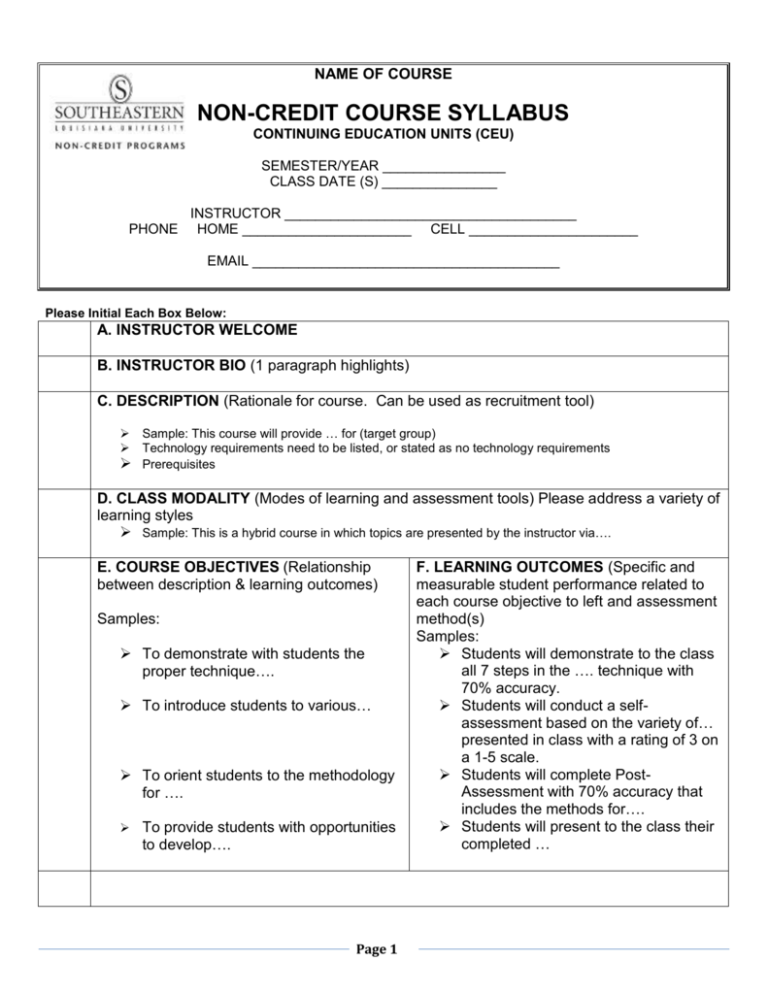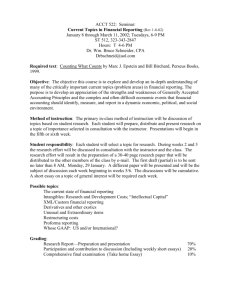q. general statement - Southeastern Louisiana University
advertisement

NAME OF COURSE NON-CREDIT COURSE SYLLABUS CONTINUING EDUCATION UNITS (CEU) SEMESTER/YEAR ________________ CLASS DATE (S) _______________ PHONE INSTRUCTOR ______________________________________ HOME ______________________ CELL ______________________ EMAIL ________________________________________ Please Initial Each Box Below: A. INSTRUCTOR WELCOME B. INSTRUCTOR BIO (1 paragraph highlights) C. DESCRIPTION (Rationale for course. Can be used as recruitment tool) Sample: This course will provide … for (target group) Technology requirements need to be listed, or stated as no technology requirements Prerequisites D. CLASS MODALITY (Modes of learning and assessment tools) Please address a variety of learning styles Sample: This is a hybrid course in which topics are presented by the instructor via…. E. COURSE OBJECTIVES (Relationship between description & learning outcomes) Samples: To demonstrate with students the proper technique…. To introduce students to various… To orient students to the methodology for …. To provide students with opportunities to develop…. Page 1 F. LEARNING OUTCOMES (Specific and measurable student performance related to each course objective to left and assessment method(s) Samples: Students will demonstrate to the class all 7 steps in the …. technique with 70% accuracy. Students will conduct a selfassessment based on the variety of… presented in class with a rating of 3 on a 1-5 scale. Students will complete PostAssessment with 70% accuracy that includes the methods for…. Students will present to the class their completed … G. COURSE TOPICS/OUTLINE The course will cover the following topics in a sequential format. H. TEXT AND REQUIRED SUPPLIES/MATERIALS (Indicate if included registration fee). List source if not supplied. I. STUDENT MONITORING AND FEEDBACK (Match each learning objective) Samples: Assignment checklist with instructor comments Pre and Post Assessments results delivered to students Student self-assessments with instructor comments Group discussion Class Demonstration J. ATTENDANCE: (Rosters required for each class) Attendance required for 10 hours per 1 CEU Because course content is sequential, your attendance is vital to the course outcome. Please contact the instructor in advance if you are unable to attend a portion of the class Note: The Instructor is responsible for rosters, but Administration will calculate CEU’s. K. CANCELLATION OF CLASSES We will make every effort to contact students if the instructor unable to attend. Web Site - Due to the unreliability of telephone service, the best way to keep informed is to check the university's Web site, www.selu.edu. A red box at the top of the page will be used to file periodic updates, including any special announcements and instructions regarding the status of classes, notices on university openings and closings and access to facilities. L. CLASSROOM RULES OF CONDUCT Samples: No electronic devices such as head phones or radios are allowed in class. No cell phones during class. No guest or children allowed in the classroom M. EMERGENCY PROCEDURES Evacuation procedures -- see instructions posted in the classroom. Emergency: Hammond: Campus security -- phone "985-549-2222" Off Campus Centers: Call 911 and notify staff in main office or police officer on duty. N. COURSE EVALUATIONS (Feedback from students) Instructors are required to collect course evaluations at the end of each course. O. RIGHT TO CANCEL COURSE The University reserves the right due to insufficient enrollment. Full refunds will be made to those students in the cancelled class. P. DISABILITY STATEMENT – "If you are a qualified student with a disability seeking accommodations under the Americans with Disabilities Act, you are required to self-identify with the Office of Disability Services, Room 203, Student Union. No accommodations will be granted without documentation from the Office of Disability Services.” Q. GENERAL STATEMENT Page 2 It is the policy of Southeastern Louisiana University not to discriminate on the basis of race, color, creed, sex, national origin, age, or disability in its admission and recruitment of students, educational programs and activities, or employment policies. The University, in its relationship with students, faculty, and staff, always treats with absolute fairness all those who apply for membership in the Southeastern community. This policy reflects the requirements of Title VII of the Civil Rights Act of 1964, as amended; the Equal Employment Opportunity Act of 1972; Executive Order 11246; Title IX of the Educational Amendments of 1972; Sections 503/504 of the Rehabilitation Act of 1973, as amended; Vietnam Era Veterans Readjustment Assistance Act of 1974; Louisiana Executive Order 13; the Americans With Disabilities Act of 1990; and the Civil Rights Act of 1991. R. EQUAL OPPORTUNITY IN EMPLOYMENT The University takes affirmative action to ensure that the following are implemented at all levels of administration: recruit, hire, place, train, and promote in all job classifications without regard to non-merit factors, except where sex is a bona fide occupational qualification; identify and use existing talent and potential through upgrading and promoting present employees (all promotions are based only on valid equal employment requirements); base decisions on employment so as to further the principles of equal employment opportunity; and ensure that all personnel actions be administered without regard to race, color, religion, sex, age, national origin, veteran status, disability, or any other non-merit factor. S. OPTIONAL BIBLIOGRAPHY OR RESOURCE REFERENCES: T. TENTATIVE SCHEDULE A daily or weekly schedule is not a required part of or required addendum to a syllabus. It does, however, help keep the course on track throughout a semester, help the instructor from "running out of time" at the end of a course, enable students to always see what is coming up or what they will miss if absent, and evidences good planning and organization. It also saves the instructor significant planning time during the course. The schedule should not be so tight that it is difficult to keep up with it or that it makes the course rigid. Until a course has been taught a couple of times, a weekly schedule is probably preferable to a daily schedule. It should be entitled "Tentative" Schedule so you are not legally at risk if you diverge from it even slightly. DATE DAY TOPIC/ACTIVITY INTRODUCTION TO THE COURSE PRE ASSESSMENT INTRODUCTION TO THE COURSE AUG 24 MON 25 TUE 26 WED EQUIPMENT AND BASIC PROCEDURES Use of equipment; fundamental operations, etc. 31 MON LETTERING Lettering form and technique SEP 2 WED SYMBOLS Materials symbols and applications SEP 6 MON POST ASSESSMENT AND COURSE EVALUATION Page 3





